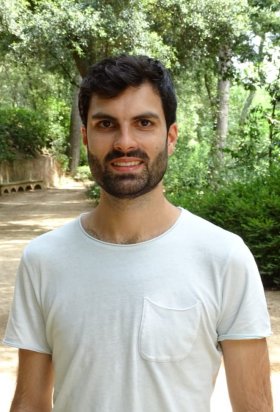Giulio Burgio

PhD Programme: Computer Science and Mathematics of Security
Research group: ALEPHSYS – Algorithms embedded in physical systems
Supervisors: Alexandre Arenas Moreno & Sergio Gómez Jiménez
Bio
Giulio Burgio obtained his bachelor's degree in physics at the University of Catania (Italy), where his interest in complex systems was born. In his bachelor's thesis, he studied how noise affects the dynamical correlations among discrete maps in a lattice to produce non trivial synchronization patterns. Following in Catania as a master's student in theoretical physics, he caught the opportunity offered by the Erasmus Plus Traineeship programme to visit the Alephsys Lab of Alex Arenas, at the URV. There he developed his master's thesis, which, combining evolutionary game theory and higher-order network representations, marked a first step for the study of the effects that many-agent interactions can have in evolutionary dynamics. Eventually, he was able to extend his stay in the Alephsys Lab, where he is working now as a PhD student.
Project: Higher-order dynamical processes on networks
Network science has given a new impetus to the study of complex systems over the last decades. Modeling real-world systems as networks, whose links represent the interactions among their units (nodes), network science was able to provide us with a new general and powerful framework to improve our understanding of those systems. However, reducing all the interactions in the system to pair-wise/dyadic ones, networks -understood as graphs- are not able to account for higher-order/many-body interactions. Biological, socio-cultural, economical, ecological systems are inherently characterized by such interactions, therefore calling for more appropriate models than those definable through graphs. Higher-order representations allow to model the intrinsic difference between a collection of pair-wise interactions (a clique of interactions) and a higher-order/many-body interaction, to which several units of the system take part simultaneously and in an irreducible way.
The general aim of the project is the proposal of physical models and theoretical methods to describe the dynamics of complex systems presenting higher-order interactions. Given a dynamical process, the main scope is to characterize how the properties of the higher-order topology of microscopic interactions in the system affect either its equilibrium macroscopic states and the possible mesoscopic patterns in it. We intend to obtain statistical measures able to predict the occurrence of phase transitions encoded in the higher-order structures found in several real systems, and - thanks to a new and deeper understanding of them - propose strategies to better control their dynamics. Among the many feasible applications there are, for example, the modeling of cooperation dynamics in social and biological systems and of (complex) contagion dynamics in social ones.
The project will be initially focused on the effect that higher-order interactions can have on the evolution of cooperation when the population of individuals possesses some topological correlations. Through the use of hypergraphs, the mechanism of network reciprocity has been recently successfully extended to many-body interactions, resulting even reinforced. Part of the project aims at deepening the understanding of such phenomenon, which may shed new light on how different forms of cooperation in societies thrives. A substantial portion of the project will then be spent to the analysis of contagion processes (epidemics, opinion and adoption dynamics, rumor spreading), proposing models and techniques to better understand how the topological and temporal distributions of higher-order interactions affects different aspects of the problem, as the conditions for which a large-scale contagion can occur and which size it may reach.
Open Access publications
- Burgio, G., Arenas, A., Gómez, S. et al. Network clique cover approximation to analyze complex contagions through group interactions. Commun Phys 4, 111 (2021). View full-text
- Burgio, G., Steinegger, B., Rapisardi, G., Arenas, A. Homophily in the adoption of digital proximity tracing apps shapes the evolution of epidemics. Physical Review Research 3, 3 (2021). View full-text
- Burgio, G., Steinegger, B. & Arenas, A. Homophily impacts the success of vaccine roll-outs. Commun Phys 5, 70 (2022). View full-text
International secondment
- University of Vermont, USA. 2 months (2023).
News
- Diari Digital de la URV. News: Researchers estimate how SARS-CoV-2 spreads depending on whether contacts are vaccinated or not



